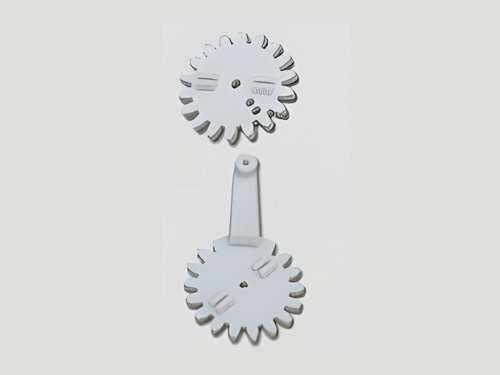Air valve mechanism
Air volume control valve actua
Air valve actuator
Remote controller for smoke ex
Air conditioning accessories
tuyere

gear
Gear is a transmission element widely used in various mechanical devices. It transmits power from one shaft to another through a specific tooth structure. The following is a detailed analysis of gears:
1. Definition and function
Gear refers to a mechanical element with teeth on the rim that can continuously mesh to transmit motion and power. It is widely used in mechanical transmission and the entire mechanical field, with the characteristics of compact structure, high efficiency, and large torque transmission.
2. Geometric shape
Gears are usually composed of three parts: gear teeth, tooth grooves, and wheel bodies:
Gear teeth: The part of the gear used to transmit power, its shape and size directly affect the transmission performance and accuracy of the gear.
Groove: The space between the gear teeth is used to accommodate the gear teeth of adjacent gears.
Wheel body: The part that supports the gear teeth and tooth grooves, usually in the shape of a disc.
3. Types
There are many types of gears, each with its own characteristics and applicable occasions. The following are some common types of gears:
Spur gears: The tooth line is parallel to the gear axis, the structure is simple, and it is easy to manufacture. It is suitable for medium and low speed transmission.
Helical cylindrical gear: The tooth line is inclined to the gear axis, forming a certain helix angle, which helps to reduce the impact and noise when the gears are meshing, improve the smoothness of the transmission, and is suitable for medium and high-speed transmission.
Herringbone cylindrical gear: The tooth surfaces on both sides are herringbone-shaped, consisting of two helical cylindrical gears, with compact structure and smooth transmission. It is suitable for high-power and high-speed transmission, but it is difficult to manufacture and has high cost.
Bevel gear (also known as helical bevel gear): The tooth surface is conical, suitable for transmission between intersecting axes, with the characteristics of smooth transmission and strong load-bearing capacity.
Worm gear: It consists of a worm and a worm wheel. The worm is spiral and the worm wheel is cylindrical. It has a large transmission ratio and is suitable for occasions with limited space and large transmission ratio, but the transmission efficiency is low and it is easy to wear.
Non-circular gear: The tooth profile is not a standard circle, but is designed according to specific motion laws. It can realize variable speed transmission and meet certain special transmission requirements.
Rack: A long transmission element with a tooth profile similar to that of a spur gear. When meshing with a gear, it can realize the conversion between linear motion and rotational motion.
Face gear: The tooth surface is a curved surface, and the transmission has a larger transmission ratio and less noise. It is suitable for high-speed and high-power transmission, but the manufacturing and installation requirements are high and the cost is high.
4. Operation principle
The operation principle of the gear involves many aspects such as the gear geometry, meshing method and transmission ratio:
Meshing method: There are mainly two types: external meshing and internal meshing. External meshing is suitable for transmission between parallel axes, while internal meshing is suitable for transmission between intersecting axes or staggered axes.
Transmission ratio: refers to the ratio of the speed of the driving gear to the driven gear, which is determined by the gear ratio. The larger the gear ratio, the greater the transmission ratio.
Operation process: When the driving gear rotates, its gear teeth will mesh with the tooth grooves of the driven gear in turn. Since the shape and size of the gear teeth and tooth grooves are precisely matched, this meshing process is very smooth and reliable. As the driving gear rotates, the driven gear will be affected by the torque and speed transmitted by the gear teeth and begin to rotate.
5. Application fields
Gear transmission is widely used in many fields due to its unique advantages:
Industrial automation equipment: such as conveyor belts, assembly lines, robots, etc.
Automobiles and aircraft: used to drive engines, transmissions, steering systems and other components.
Mechanical equipment: such as machine tools, elevators, cranes, etc.
Agricultural machinery: such as tractors, harvesters, etc.
Medical equipment: such as transmission systems in equipment such as X-ray machines and CT scanners.
Aerospace: such as transmission systems in spacecraft such as satellites and rockets.
Entertainment facilities: such as transmission systems of vehicles such as bicycles and scooters.
In summary, gears, as important components in mechanical transmission, play an irreplaceable role in various fields. With the continuous advancement and innovation of technology, the performance and application scope of gears will continue to expand and improve.
Working principle of the actuator of the air volume control valve
Electric air volume control valve, as an intelligent air duct equipment, is widely used in air conditioning systems in fields such as construction, medical care, and industry. It can automatically adjust the opening of the valve according to the air flow
2024-05-06
The execution content of the fire damper actuator
To drive the valve action, a matching actuator is required. The actuator used for fire dampers may not be electrically driven, but may also be electrically driven.
2024-05-06
The structural composition of the fire damper actuator
The fire damper actuator is a type of actuator used for fire dampers in ventilation and air conditioning system pipelines, which solves the problem of inaccurate adjustment of the opening angle of valve blades, thus unable to accurately control the ventil
2024-05-06
What functions can the actuator of the air volume control valve achieve?
The actuator of the air flow regulating valve is an automated equipment used to control the air flow valve in ventilation ducts. It can automatically adjust the opening of the air valve by receiving signals from the control system to achieve the goal of c
2024-05-06
